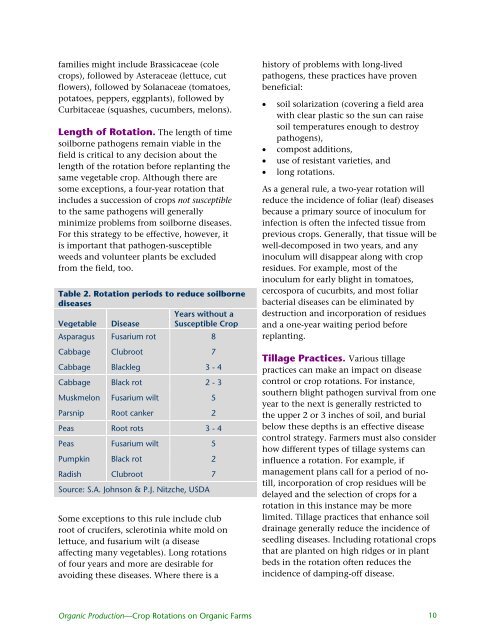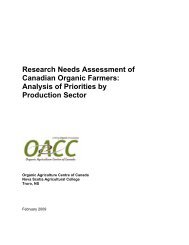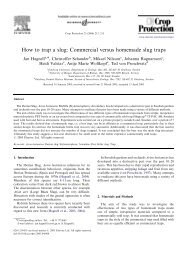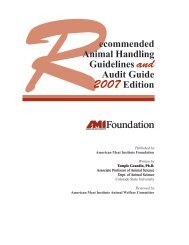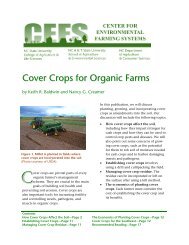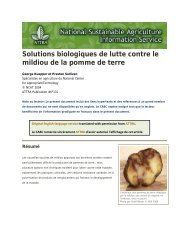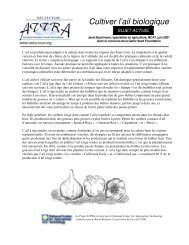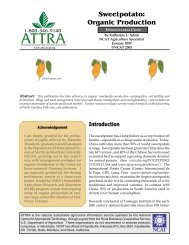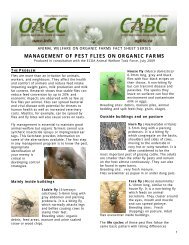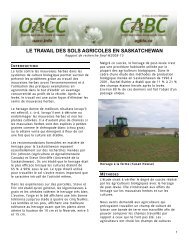You also want an ePaper? Increase the reach of your titles
YUMPU automatically turns print PDFs into web optimized ePapers that Google loves.
families might include Brassicaceae (colecrops), followed by Asteraceae (lettuce, cutflowers), followed by Solanaceae (tomatoes,potatoes, peppers, eggplants), followed byCurbitaceae (squashes, cucumbers, mel<strong>on</strong>s).Length of Rotati<strong>on</strong>. The length of timesoilborne pathogens remain viable in thefield is critical to any decisi<strong>on</strong> about thelength of the rotati<strong>on</strong> before replanting thesame vegetable crop. Although there aresome excepti<strong>on</strong>s, a four-year rotati<strong>on</strong> thatincludes a successi<strong>on</strong> of crops not susceptibleto the same pathogens will generallyminimize problems from soilborne diseases.For this strategy to be effective, however, itis important that pathogen-susceptibleweeds and volunteer plants be excludedfrom the field, too.Table 2. Rotati<strong>on</strong> periods to reduce soilbornediseasesYears without aVegetable Disease Susceptible <str<strong>on</strong>g>Crop</str<strong>on</strong>g>Asparagus Fusarium rot 8Cabbage Clubroot 7Cabbage Blackleg 3 - 4Cabbage Black rot 2 - 3Muskmel<strong>on</strong> Fusarium wilt 5Parsnip Root canker 2Peas Root rots 3 - 4Peas Fusarium wilt 5Pumpkin Black rot 2Radish Clubroot 7Source: S.A. Johns<strong>on</strong> & P.J. Nitzche, USDASome excepti<strong>on</strong>s to this rule include clubroot of crucifers, sclerotinia white mold <strong>on</strong>lettuce, and fusarium wilt (a diseaseaffecting many vegetables). L<strong>on</strong>g rotati<strong>on</strong>sof four years and more are desirable foravoiding these diseases. Where there is ahistory of problems with l<strong>on</strong>g-livedpathogens, these practices have provenbeneficial:• soil solarizati<strong>on</strong> (covering a field areawith clear plastic so the sun can raisesoil temperatures enough to destroypathogens),• compost additi<strong>on</strong>s,• use of resistant varieties, and• l<strong>on</strong>g rotati<strong>on</strong>s.As a general rule, a two-year rotati<strong>on</strong> willreduce the incidence of foliar (leaf) diseasesbecause a primary source of inoculum forinfecti<strong>on</strong> is often the infected tissue fromprevious crops. Generally, that tissue will bewell-decomposed in two years, and anyinoculum will disappear al<strong>on</strong>g with cropresidues. For example, most of theinoculum for early blight in tomatoes,cercospora of cucurbits, and most foliarbacterial diseases can be eliminated bydestructi<strong>on</strong> and incorporati<strong>on</strong> of residuesand a <strong>on</strong>e-year waiting period beforereplanting.Tillage Practices. Various tillagepractices can make an impact <strong>on</strong> diseasec<strong>on</strong>trol or crop rotati<strong>on</strong>s. For instance,southern blight pathogen survival from <strong>on</strong>eyear to the next is generally restricted tothe upper 2 or 3 inches of soil, and burialbelow these depths is an effective diseasec<strong>on</strong>trol strategy. Farmers must also c<strong>on</strong>siderhow different types of tillage systems caninfluence a rotati<strong>on</strong>. For example, ifmanagement plans call for a period of notill,incorporati<strong>on</strong> of crop residues will bedelayed and the selecti<strong>on</strong> of crops for arotati<strong>on</strong> in this instance may be morelimited. Tillage practices that enhance soildrainage generally reduce the incidence ofseedling diseases. Including rotati<strong>on</strong>al cropsthat are planted <strong>on</strong> high ridges or in plantbeds in the rotati<strong>on</strong> often reduces theincidence of damping-off disease.<strong>Organic</strong> Producti<strong>on</strong>—<str<strong>on</strong>g>Crop</str<strong>on</strong>g> <str<strong>on</strong>g>Rotati<strong>on</strong>s</str<strong>on</strong>g> <strong>on</strong> <strong>Organic</strong> <strong>Farms</strong> 10


